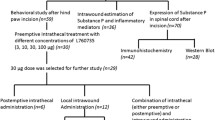Abstract
Objective and Design:
The present investigation was aimed at assessing the involvement of primary sensory neurons in the hyperalgesia induced by the intrathecal injection of PGE2, as well as whether the hyperalgesic effect was due to the spinal release of glutamate.
Material:
Male Wistar rats were used.
Methods:
Hyperalgesia was measured using the rat paw pressure test.
Results:
Intrathecal PGE2 (2.5–50 ng/rat) administration caused a dose-dependent hyperalgesia in both paws. Ipsilateral intraplantar injections of morphine (0.5–8 μg/paw) or SNAP (S-nitroso-N-acetyl-D,L-penicillamine, 50–200) μg/paw) dose-dependently antagonized spinally-induced PGE2 hyperalgesia (ANOVA, p<0.001). Their antinociceptive effects were confirmed to be peripheral by abolition following pretreatment of the paws with L-NMMA (NG-monomethyl-L-arginine monoacetate), 50 μg/paw or with methylene blue (500 μg/paw). The spinally-induced PGE2 hyperalgesia was antagonized by intrathecal injections (9 μg) of AP5 (2-amino-5-phosphonopentanoate/2-amino-5) a selective NMDA receptor antagonist.
Conclusions:
Intrathecal administration of PGE2 seems to cause hyperalgesia by spinal sensitization of the primary afferent neuron through the release of glutamate.
Similar content being viewed by others
References
Ramwell PW, Shaw JE, Jessup R. Spontaneous release of prostaglandins from frog spinal cord. Am J Physiol 1966;998–1004.
Minami T, Uda R, Horiguchi S, Ito S, Hyodo M, Hayaishi O. Allodynia evoked by intrathecal administration of prostaglandin E2 to conscious mice. Pain 1994;57:217–23.
Nishihara I, Minami T, Uda R, Ito S, Hyodo M, Hayaishi O. Effect of NMDA receptor antagonists on prostaglandin E2-induced hyperalgesia in conscious mice. Brain Res 1995;677:138–44.
Duarte IDG, Lorenzetti BB, Ferreira SH. Peripheral analgesia and activation of the nitric oxide-cyclic GMP pathway. Eur J Pharmacol 1990;186:289–93.
Ferreira SH, Lorenzetti BB. Glutamate spinal retrograde sensitization of primary sensory neurons associated with nociception. Neuropharmacology 1993;33:1479–85.
Malmberg AB, Yaksh TL. Hyperalgesia medicated by spinal glutamate or substance P receptor blocked by spinal cyclo-oxygenase inhibition. Science 1992;257:1276–9.
Ferreira SH, Lorenzetti BB, Correa FMA. Central and peripheral antialgesic action of aspirin-like drugs. Eur J Pharmacol 1978;53:39–48.
Papir-Kricheli D, Frey J, Laufer R, Gilon C, Chorev M, Selinger Z, et al. Behavioural effects of receptor-specific substance P agonists. Pain 1987;31:263–76.
Yamamoto T, Yaksh TL. Spinal pharmacology of thermal hyperesthesia induced by constriction injury of sciatic nerve. Excitatory amino acid antagonists. Pain 1992;49:121–8.
Haley JE, Sullivan AF, Dickenson AH. Evidence for spinal N-methyl-D-aspartate receptor involvement in prolonged chemical nociception in the rat. Brain Res 1990;518:218–26.
Sher GD, Mitchell D. Intrathecal N-methyl-D-aspartate induces hyperexcitability in rat dorsal horn corvergent neurones. Neurosci Lett 1990;119:199–202.
Duarte IDG, Santos IR, Lorenzetti BB, Ferreira SH. Analgesia by direct antagonism of nociceptor sensitization involves the arginine-nitric oxide-cGMP pathway. Eur J Pharmacol 1992;217:225–7.
Mayer B, Brunner F, Schmidt K. Inhibition of nitric oxide synthesis by methylene blue. Biochem Pharmacol 1993;45: 367–74.
Coderre TJ, Melzack R. The role of NMDA receptor-operated calcium channels in persistent nociception after formalin-induced tissue injury. J Neurosci 1992;12:3671–5.
Jeftinija S, Jeftinija K, Liu F, Skilling SR, Smullin DH, Larson AA. Excitatory amino acids are released from rate primary afferent neurons in vitro. Neurosci Lett 1991;125: 191–4.
Author information
Authors and Affiliations
Additional information
accepted by K. Brune and M. J. Parnham
Rights and permissions
About this article
Cite this article
Ferreira, S.H., Lorenzetti, B.B. Intrathecal administration of prostaglandin E2 causes sensitization of the primary afferent neuron via the spinal release of glutamate. Inflamm Res 45, 499–502 (1996). https://doi.org/10.1007/BF02311085
Received:
Revised:
Accepted:
Published:
Issue Date:
DOI: https://doi.org/10.1007/BF02311085




